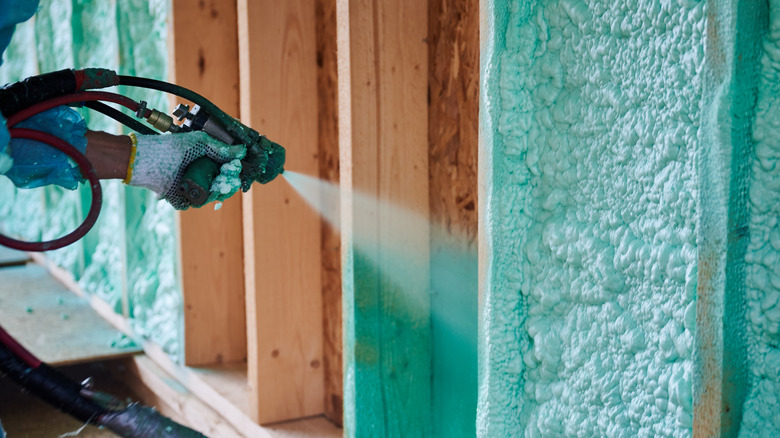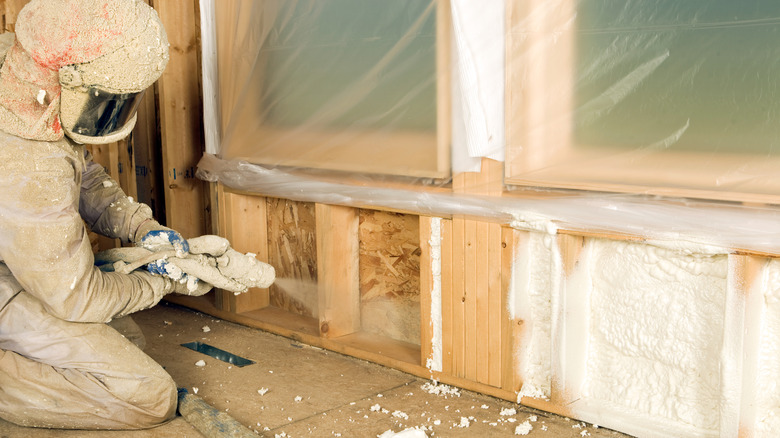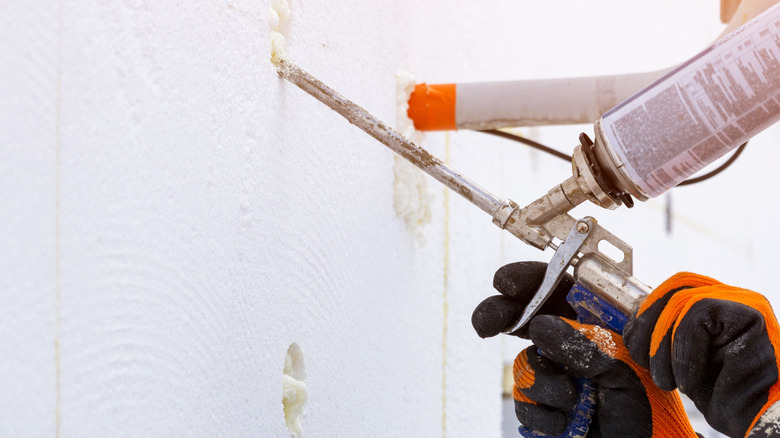How Much Does Spray Foam Insulation Cost? Here's Everything You Need To Know
It's strangely difficult to puzzle out the cost of spray foam insulation. There are a surprising number of factors to be taken into account; in some ways, it would be more sensible to ask a question like, "How much does a car cost?" There are, however, some meaningful numbers we can look at without getting bogged down in minute details. This starts with the cost per board foot of the two types of spray foam insulation: open-cell and closed-cell. Open-cell insulation costs between $.41 and $.80 per board foot, while closed-cell insulation usually costs between $1.05 and $1.96, based on our roundup of 10 national surveys. That translates to $1,454 to $4,336 for a typical project, or as little as $670 for a small HVAC project, or perhaps sealing that huge air leak under your bathtub.
However, this is just scratching the surface, as the ultimate price of installing spray foam insulation depends largely on the additional costs that pile up. Some of these are considerable and some are negligible, but unless you buy one of those DIY spray foam insulation kits, the largest by far is the cost of labor. Depending on your market, labor for a typical job runs 27-39% of typical project expenses, and 35-48% of a premium, rush, or emergency job. Labor costs are also affected by where the insulation is being installed. Installing spray foam to an uninsulated attic is generally the cheapest while applying it to basement walls tends to be the most pricey. Labor typically runs anywhere from 39% to 93% of the cost of materials.
Factors that affect the cost of spray foam insulation
Among the many factors that affect the short- and long-term cost of spray foam installation are the complexity of the project, the size and accessibility of the area to be insulated, the desired thickness of the insulation, the home's geographical location, and of course the pricing scale of the installation company. With respect to the part of the house being insulated, attics typically cost the least and basements tend to be the priciest. The area in which you live can add 22-40% to your bill, with the Southeast being the cheapest and the West Coast the most expensive. If your installer was hired by your general contractor, you can expect to pay a 13-22% markup for the benefit of not overseeing the work yourself.
These factors can all affect the rate you pay for the basic installation of spray foam, but there are many more fees and upcharges you might have to confront. The list of these is positively terrifying, but keep in mind that you are unlikely to encounter more than a handful of these. It includes repairing, removing, relocating, improving, or modifying existing structural elements or systems like HVAC, plumbing, and electrical wiring. You will also get dinged if your contractor needs to bring any of these up to code. Removing old insulation or other items will cost you, as will testing for and removal of hazards like asbestos or lead. Finally, you will have to deal with sales taxes and permit/inspection fees.
Choosing the right type of foam insulation for your home
Fortunately, you may be able to save money by installing cheaper spray foam insulation, depending on your home's needs. Open-cell foam is a less expensive option, while closed-cell foam is more effective but also more expensive. The cheapest open-cell foam might cost as little as $.25 per board foot, while the most expensive closed-cell foam can run as much as $3.10 per board foot or more. Open-cell spray foam does have its uses, however. It expands several times more than closed-cell, so it's ideal for filling cracks and covering difficult-to-reach spaces. Open-cell foam can also make sense when there's little chance of moisture intrusion. Closed-cell foam is far more moisture-resistant, so it's more suitable for moisture-prone areas like attics, crawl spaces, and basements, and for preventing condensation on metal sheds, roofs, and walls.
In terms of energy efficiency, spray foam outperforms most other insulation materials like fiberglass and cellulose, which means savings on your energy bills — potentially 15-50% per year — and those savings start the day you spray. In the long term, you could save $500-2000 per year on maintenance to both your insulation and your home, thanks to spray foam's superior moisture management properties. You might even see a 5-10% increase in your home's value while staying perfectly comfortable in your nicely insulated space.


